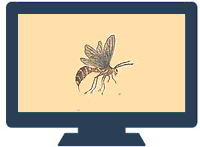Entomology, Department of

Department of Entomology: Distance Master of Science Projects
Date of this Version
2018
Document Type
Project
Citation
University of Nebraska-Lincoln Department of Entomology Online Masters Program Final Project. Lincoln, Nebraska.
Abstract
The Red Legged Ham Beetle (Necrobia rufipes), RLHB has fascinated me since the moment we met. The beautiful greens and blues that sparkle from its elytra, the sharp and fast red legs that flash just below the body and just last month I was able to see a RLHB in flight for the first time. My squeal of delight was not left un-mocked by my coworkers. This beetle is a detrimental and determined stored product pest. One that, we in the pet food business, don’t take lightly. This generated a need for control in warehousing as distribution but also in the most challenging of environments, the pet food store. The RLHB has an extra oily exoskeleton. The beetle will also close up it spherical as a reaction to changes in the environment. As a result, all fumigants must be used at max dosing to have an impact on a population. This is not a feasible solution in a pet food store, particularly one that contains, well…pets. So how do you control an insect population in a store with live animals? Obviously cleaning and sanitation but if you don’t know anything about the insect, where do you focus? How do you make your cleaning efficient? You can’t! I needed to learn as much as I could about the RLHB. Not only because it was intriguing and then mesmerizing, but because my job depended on it. To begin Integrated Pest Management (IPM), I needed answers to these questions: - What attracts the RLHB? - Where does it harborage? - How do I educate the pest control industry on the RLHB to prevent future misidentifications, consumer complaints and lost product? - How do I deter them or kill them when they’re already damaging stored products? o AND how do I do this safely? o Organically? o Easily? o Without harm to the stores?
There are four parts to my project. First, I will determine what best attracts the RLHB. I will use the information I know about origin and background as well as current industry practices to try and find a monitoring solution. Monitoring is key to an IPM program and without it, I’m setting myself up for failure. I will document a choice study. Second, I will determine a pet safe way to control a RLHB population. What will kill them? How long will it take to kill them and how much of it do I need to kill them? I will apply a desiccant at varying rates and record the time is takes for desiccation to occur and at what application rates. Third, I will apply the gathered information and use it in 2 pet food stores in Texas. How do I use what I’ve learned about monitoring and application to help the pet food stores? Will this actually work in a real life example? I will monitor for the beetles to determine appropriate application area, then apply desiccant for multiple months while recording any and all population changes. Seeing a reduction in over 90% of the population will constitute a successful application and treatment method. Lastly, I will create educational materials and a repeatable plan to share what I’ve learned. This information will be used to educate pest control companies, other industry and to repeat this process in the future. This research began when I started my graduate studies. The research took many many years, many many airplane rides and even more blood, sweat and tears. I will share with you my complete works from the collection and observation of the species to data collected from pet food stores in Texas as well as my current conversations on how to repeat this process in additional stores in Arizona with RLHB infestation and presentations to professionals across the country on how to safely control the beautiful Necrobia rufipes.


Comments
Copyright 2018 Alexandria Hammel